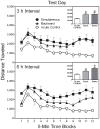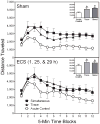Importance of associative learning processes for one-trial behavioral sensitization of preweanling rats
- PMID: 21897205
- PMCID: PMC3174322
- DOI: 10.1097/FBP.0b013e32834affb2
Importance of associative learning processes for one-trial behavioral sensitization of preweanling rats
Abstract
During adulthood, associative learning is necessary for the expression of one-trial behavioral sensitization; however, it is uncertain whether the same associative processes are operative during the preweanling period. Two strategies were used to assess the importance of associative learning for one-trial behavioral sensitization of preweanling rats. In the initial experiments, we varied both the sequence and time interval between presentation of the conditioned stimulus (CS, novel environment) and unconditioned stimulus (US, cocaine). In the final experiment, we determined whether electroconvulsive shock-induced retrograde amnesia would disrupt one-trial behavioral sensitization. Results showed that robust-sensitized responding was apparent regardless of the sequence in which cocaine and the novel environment (the presumptive CS) were presented. Varying the time between CS and US presentation (0, 3, or 6 h) was also without effect. Results from experiment 3 showed that single or multiple electroconvulsive shock treatments did not alter the expression of the sensitized response. Therefore, these data indicated that one-trial behavioral sensitization of preweanling rats was exclusively mediated by nonassociative mechanisms and that associative processes did not modulate sensitized responding. These findings are in contrast to what is observed during adulthood, as adult rats exhibit one-trial behavioral sensitization only when associative processes are operative.
Figures







Similar articles
-
Importance of environmental context for one- and three-trial cocaine-induced behavioral sensitization in preweanling rats.Psychopharmacology (Berl). 2009 Oct;206(3):377-88. doi: 10.1007/s00213-009-1616-2. Epub 2009 Jul 28. Psychopharmacology (Berl). 2009. PMID: 19636537 Free PMC article.
-
Cocaine-induced behavioral sensitization in preweanling and adult rats: effects of a single drug-environment pairing.Psychopharmacology (Berl). 2007 Aug;193(3):323-32. doi: 10.1007/s00213-007-0788-x. Epub 2007 Apr 21. Psychopharmacology (Berl). 2007. PMID: 17450351
-
One-trial cocaine-induced behavioral sensitization in preweanling rats: role of contextual stimuli.Exp Clin Psychopharmacol. 2010 Jun;18(3):284-95. doi: 10.1037/a0019142. Exp Clin Psychopharmacol. 2010. PMID: 20545393 Free PMC article. Clinical Trial.
-
Psychostimulant induced behavioral sensitization: The contribution of drug stimuli to context and Pavlovian conditioned stimuli.Pharmacol Biochem Behav. 2025 Jun;251:174011. doi: 10.1016/j.pbb.2025.174011. Epub 2025 Apr 4. Pharmacol Biochem Behav. 2025. PMID: 40188970 Review.
-
Repeated formaldehyde effects in an animal model for multiple chemical sensitivity.Ann N Y Acad Sci. 2001 Mar;933:57-67. doi: 10.1111/j.1749-6632.2001.tb05814.x. Ann N Y Acad Sci. 2001. PMID: 12000036 Review.
Cited by
-
Importance of D1 and D2 receptor stimulation for the induction and expression of cocaine-induced behavioral sensitization in preweanling rats.Behav Brain Res. 2017 May 30;326:226-236. doi: 10.1016/j.bbr.2017.03.001. Epub 2017 Mar 8. Behav Brain Res. 2017. PMID: 28284952 Free PMC article.
-
Age-dependent differences in the strength and persistence of psychostimulant-induced conditioned activity in rats: effects of a single environment-cocaine pairing.Behav Pharmacol. 2014 Oct;25(7):695-704. doi: 10.1097/FBP.0000000000000085. Behav Pharmacol. 2014. PMID: 25171082 Free PMC article.
-
Ontogeny of methamphetamine-induced and cocaine-induced one-trial behavioral sensitization in preweanling and adolescent rats.Behav Pharmacol. 2012 Aug;23(4):367-79. doi: 10.1097/FBP.0b013e32835651c9. Behav Pharmacol. 2012. PMID: 22732208 Free PMC article.
-
Early ontogeny of D-amphetamine-induced one-trial behavioral sensitization.Pharmacol Biochem Behav. 2013 Mar;104:154-62. doi: 10.1016/j.pbb.2013.01.016. Epub 2013 Jan 27. Pharmacol Biochem Behav. 2013. PMID: 23360956 Free PMC article.
-
Role of the D1 receptor for the dopamine agonist-induced one-trial behavioral sensitization of preweanling rats.Psychopharmacology (Berl). 2014 Oct;231(21):4167-77. doi: 10.1007/s00213-014-3561-y. Epub 2014 Apr 17. Psychopharmacology (Berl). 2014. PMID: 24740494 Free PMC article.
References
-
- Anagnostaras SG, Robinson TE. Sensitization to the psychomotor stimulant effects of amphetamine: modulation by associative learning. Behav Neurosci. 1996;110:1397–1414. - PubMed
-
- Anagnostaras SG, Schallert T, Robinson TE. Memory processes governing amphetamine-induced psychomotor sensitization. Neuropsychopharmacology. 2002;26:703–715. - PubMed
-
- Andrade C, Thyagarajan S, Vinod PS, Srikanth SN, Rao NS, Chandra JS. Effect of stimulus intensity and number of treatments on ECS-related seizure duration and retrograde amnesia in rats. J ECT. 2002;18:197–202. - PubMed
-
- Andrade C, Singh NM, Thyagarajan S, Nagaraja N, Rao NSK, Chandra JS. Possible glutamatergic and lipid signalling mechanisms in ECT-induced retrograde amnesia: experimental evidence for involvement of COX-2, and review of literature. J Psychiatr Res. 2008;42:837–850. - PubMed
-
- Ayres JJB, Haddad C, Albert M. One-trial excitatory backward conditioning as assessed by suppression of licking in rats: concurrent observation of lick suppression and defensive behaviors. Anim Learn Behav. 1987;15:212–217.
Publication types
MeSH terms
Substances
Grants and funding
LinkOut - more resources
Full Text Sources

